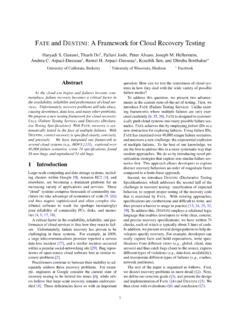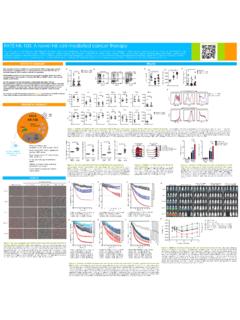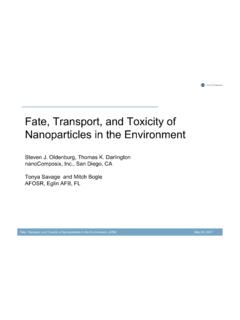Transcription of The Environmental Characteristics of MTBE: Fate, Transport ...
1 In Aqua Veritas, LLC Technical Report TR-0020- mtbe The Environmental Characteristics of mtbe : Fate, Transport , remediation & comparison w/ ethanol July, 2003 Prepared By: Tim Douthit In Aqua Veritas, LLC 850 Mt. Pleasant Avenue Ann Arbor, Michigan 48103 Table of Contents Introduction and Scope 1 The Introduction of mtbe from Gasoline into Groundwater 2 mtbe and the Composition of Gasoline 2 mtbe s Solubility Relative to Other Gasoline Constituents 4 Dissolved-Phase Fate and Transport of mtbe 8 Natural Attenuation 10 Empirical Plume Data 16 mtbe remediation Options 19 ethanol vs mtbe 22 Summary 23 Exhibits Exhibit 1 Approximate Raoult s Law Mixture Solubility of Selected Gasoline Components 6 Exhibit 2 Dissolved Concentration of Selected Gasoline Components in contact w/Gasoline 6
2 Exhibit 3 Volatility of Selected Gasoline Components 7 Exhibit 4 Koc and Retardation Factors of Selected Gasoline Components 9 Exhibit 5 Henry s Law Constant (H) of Selected Gasoline Components 11 Exhibit 6 Aqueous Anaerobic Degradation Rate of Selected Gasoline Components 13 Exhibit 7 mtbe Biodegradation Rates from Field Studies 14 Introduction and Scope The following document contains information and references relevant to: The introduction of mtbe into subsurface soils and groundwater the fate and Transport of dissolved-phase mtbe Methods and technologies applicable to the remediation of mtbe These topics are presented with discussion comparing mtbe to other gasoline constituents, including ethanol , and how the interchange of these constituents may affect the Environmental management of gasoline releases.
3 This report represents an analysis based on professional experience and research as well as review of available third-party publications as referenced at the end of the text. However, the general field of mtbe (and other oxygenate) research is dynamic and new information is constantly being produced. Therefore the reader is encouraged to supplement this document with current reports, conference documents, seminars, etc. The Introduction of mtbe from Gasoline into Groundwater mtbe and the Composition of Gasoline mtbe has been used as an ingredient in gasoline since the late 70 s1. Originally used as an octane enhancer during the phase-out of alkyl lead compounds, mtbe was also used subsequently as an oxygenate to help meet automotive emissions standards.
4 Widespread use of mtbe in gasoline started in the early 90 s as a response to the wintertime oxygenated gasoline program, part of the Clean Air Act Amendments of 19902. Presently mtbe makes up approximately 11% of RFG by volume3. Before the incorporation of mtbe in gasoline, the Environmental management of gasoline release sites relied on the analysis of other gasoline constituents in soil and groundwater samples in order to delineate gasoline-impacted areas and assess the severity of subsurface contamination by gasoline. Typically, several indicator compounds were chosen as signals that gasoline contamination existed. The indicator compounds were chosen either on the basis of being present in high concentrations within gasoline, or their toxicity, or both.
5 The higher the concentration of an indicator compound within gasoline, the more likely would be its detection in Environmental samples. The higher the toxicity of an indicator compound within gasoline, the more important its subsurface characterization became with respect to potential adverse effects on human health and the environment. Additionally, indicator compounds were chosen on the basis of high subsurface mobility compared to the remaining constituents of gasoline. Therefore, if the subsurface extent of the gasoline indicator compounds had been completely delineated, one 1 Gibbs, 1990.
6 Gasoline Additives When and Why. SAE Technical Paper Series 902104 2 Gibbs, 1993. How Gasoline has Changed. SAE Technical Paper Series 932828 3 Note that due to the similarity in specific gravity (density relative to water) of both mtbe and gasoline (approximately ), the volume percent and weight percent of mtbe in gasoline are approximately numerically equivalent. 3could assume that the subsurface distribution of the remaining, less mobile gasoline constituents would be less extensive. In general, the most popular gasoline indicator compounds, prior to the advent of mtbe , were benzene, toluene, ethylbenzene and xylenes, collectively referred to as BTEX.
7 Benzene averages about weight percent in gasoline, while toluene, ethylbenzene and xylenes average about , and weight percent in gasoline, respectively4. Thus, BTEX represents approximately 20% of the total composition of gasoline by weight. Further, benzene is classified as a known carcinogen, and relative to most gasoline constituents was considered to have high subsurface mobility. Most gasoline release sites in New York, prior to the advent and/or awareness of mtbe were, in fact, regulated on the basis of BTEX alone if a site s BTEX concentrations in soil and groundwater were below regulatory limits, then it was assumed both by regulators and the regulated community, that the remaining gasoline constituents were of no additional Environmental concern.
8 Now that the Environmental industry has become aware of the relative abundance of mtbe in gasoline and the unique challenges posed by mtbe (and other oxygenates) to the management of gasoline release sites, the traditional suite of gasoline indicator compounds (BTEX) has been joined, at a minimum, by mtbe in most soil and groundwater analyses conducted during routine subsurface delineation and compliance sampling events. 4 Potter, and Simmons, 1998. Composition of Petroleum Mixtures. TPH Criteria Working Group Series, Volume 2. Amherst Scientific Publishers, Amherst MA. mtbe s Solubility Relative to Other Gasoline Constituents When gasoline is spilled, a number of different scenarios may be realized.
9 In the event of a small surface spill, the bulk of the spill may simply evaporate, especially if the spill occurred on a relatively impermeable surface such as concrete. Some smaller subsurface gasoline releases, for example an isolated underground storage tank (UST) overfill event, may result in the gasoline being adsorbed onto soil particles and held in soil interstices (termed free-phase immobile gasoline), especially in cases where groundwater is deep and/or soils are relatively impermeable (clay and silt-rich sediments). However, gasoline spills occasionally occur in volumes that overwhelm the soil s adsorption and storage capacity, resulting in the continued downward percolation of gasoline (termed free-phase mobile gasoline) through the soil until the gasoline comes into contact with groundwater.
10 Once it comes into contact with groundwater, being less dense than water, the gasoline essentially forms a floating layer on top of the groundwater5 and begins to dissolve (dissolved-phase gasoline). Alternatively, if the soil through which the gasoline is percolating is also subject to rainwater infiltration, some dissolution of gasoline may occur prior to its reaching groundwater as infiltrating rainwater comes into contact with the gasoline. The dissolution of gasoline is a complex process, since gasoline is a mixture of many components. In a mixture, the solubility of any one component of the mixture is affected by the presence of the other components in the mixture.









